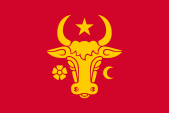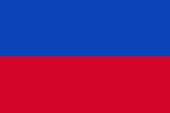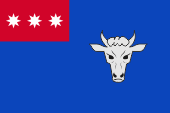Moldau |
|
|
|
| Übersicht – Contents: | |
Moldau |
|
|
|
| Übersicht – Contents: | |
Flaggen – Flags: |
|
 |
14.–15. Jhd./century, |
 |
18./19. Jhd./century, |
 |
1858–1861, |
| Als Landesfarben von Moldau gelten Blau und Rot. Diese leiten sich offenbar nicht vom Wappen ab. Das traditionelle Gelb-Rot des Wappens wurde wahrscheinlich im 18. Jahrhundert durch die Kombination Rot-Blau abgelöst. Die Gründe dafür sind nicht bekannt. Schließlich verlieh Sultan Mahmud II. den Moldauischen Truppen in der ersten Hälfte des 19. Jahrhunderts rot-blaue Wimpel → rot-blau anstelle blau-rot. Das ist immer dann von Bedeutung, wenn es um den Ursprung der Farben der rumänischen Flagge geht. Die rumänischen Farben Blau, Gelb und Rot entstanden während der Revolution der Jahre 1848/1849 durch die Kombination der Farben des Fürstentums Walachei und des Fürstentums Moldau, nämlich Gelb/Blau und Rot/Blau. Es hat aber eher den Anschein, das Blau, Gelb und Rot schon vorher in der Walachei verwendet wurden, und auch der offizielle Name des Fürstentums Walachei "Principatul Tării Românesti" zeigte schon die Verwendung des Therms "Rumänisch". Wie auch immer, im Jahre 1861 entstand der Staat Rumänien durch die Vereinigung dieser beiden Fürstentümer. | As
colours of the country of Moldavia were used blua and red. Those are
obviously not derived from the coat of arms. The traditional yellow-red of
the coat of arms was probably replaced by the combination red-blue in the
18th century. The reasons for this are not known. Finally, in the first half
of the 19th century, Sultan Mahmud II awarded the Moldavian troops red-blue
pennants → red-blue instead of blue-red. This is always significant when it is asked for the origin of the colours of the Romanian flag. The Romanian colours blue, yellow and red were created during the revolution of 1848/1849 by combining the colours of the Principality of Wallachia and the Principality of Moldavia, namely yellow/blue and red/blue. However, it seems that blue, yellow and red had already been used in Wallachia, and the official name of the Principality of Wallachia "Principatul Tării Românesti" also showed the use of the Romanian term. However, in 1861, the state of Romania was created by the union of these two principalities. |
| Quelle/Source: Flags of the World, Wikipedia (EN), Volker Preuß | |
Wappen – Coat of Arms: |
|
 |
Wappen von Moldau – coat of arms of Moldavia, Quelle/Source, nach/by: Flags of the World, Wikipedia (EN) |
|
|
|
| Das
Wappen der Moldau zeigte ursprünglich einen goldenen Auerochsenkopf auf rotem
Grund. Aber er erschien oft recht wechselhaft, so war der Auerochsenkopf auch
silbern auf Rot oder sogar schwarz auf Rot. Auch weiße Wappenschilde mit einem naturfarbenen Stierkopf sind bekannt. Nach 1856 – dem Jahr des Erwerbs der Norddobrudscha – wurde das Wappen von zwei stilisierten Delphinen begleitet. Sie sind (golden auf Blau) die Wappentiere der Dobrudscha. |
The coat
of arms of Moldavia showed initially a golden bull's head on red ground. But
it often appeared quite changeable, so the aurochs head was also silver
on red or even black on red. Even white blazons with an ecru-coloured bull's head are known. After 1856 – the year of the earning of the Northern Dobruja – the coat of arms was escorted by two stylized dolphins. They are (in gold on blue) the arms animals of the Dobruja. |
| Quelle/Source: Wikipedia (EN), World Statesmen, Volker Preuß | |
| interaktive Landkarte – interactive Map: |
| Die historischen Regionen in Rumänien – The historical Regions in Romania |
|
|
|
| Zahlen und Fakten – Numbers and Facts: | |
|
|
|
|
|
|
|
|
|
|
|
|
| ca. 2000
v.Chr. · Herausbildung des Volkes der Thraker in Dakien (heutiges
Siebenbürgen) 7. Jahrhundert v.Chr. · Gründung griechischer Kolonien an der Küste des Schwarzen Meeres 4. bis 6. Jahrhundert · Völkerwanderung, durch die Ausbreitung der Hunnen in Mittelasien werden ganze Völkerschaften nach Westen gedrängt, die Hunnen schieben die Slawen vor sich her, und diese die Germanen, die Germanen weichen auf das Gebiet des Römischen Reichs aus 6. Jahrhundert · Einwanderung von Slawen 7. Jahrhundert · aus den verbliebenen Dako-Römern entsteht das Volk der Dako-Romanen, Ausbreitung in Richtung der heutigen Walachei und Moldau 9. bis 13. Jahrhundert · Invasionen der Petschenegen, Kumanen und Tataren 13. Jahrhundert · ein Volk der Rumänen wird erstmals urkundlich erwähnt 1359 · Gründung des Fürstentums Moldau zwischen den Karpaten und dem Dnjestr während des Kampfes gegen die Tataren 1387 · Abhängigkeit von Polen-Litauen 1400 · erste türkische Angriffe gegen Moldau und Walachei 1455 · das Fürstentum Moldau wird dem Osmanischen Reich tributpflichtig 1461 · Fürst Stephan der III. von Moldau (der Große, ca. 1435–1504) erwibt die Walachei 1475 · Aufstand des Fürstentums Moldau unter Fürst Stephan dem Großen, Sieg über die Türken, Wiederherstellung der Unabhängigkeit von Moldau und Walachei 1497 · Fürst Stephan der Große besiegt Ungarn und Polen, Bewahrung der Unabhängigkeit der Moldau 1511 · Moldau wird vom Osmanischen Reich unter beschränkter innerer Autonomie annektiert 1600 · Michael der Tapfere, Fürst der Walachei, wird Fürst von Moldau 19.08.1601 · Michael der Tapfere wird ermordet, Walachei und Moldau müssen die türkische Oberhoheit endgültig anerkennen 1711 · die Türken besiegen die moldauisch-russischen Befreiungsarmeen, die Fürsten der Moldau und der Walachei werden abgesetzt und durch griechische Statthalter (Phanarioten) ersetzt ab 1774 · wieder Zunahme des russischen Einflusses 1775 · Abtretung des Buchenlandes (Bukowina) an Österreich 1806–1812 · Russisch-Türkischer Krieg 1812 · Frieden von Bukarest, der östliche Teil des rumänischen Fürstentums Moldau (zwischen den Flüssen Prut und Dnjestr) kommt unter dem Namen Bessarabien (heutiges Moldawien) an Russland 1821 · großer Anti-Türkischer Aufstand in der Walachei unter Tudor Vladimirescu, griechischer Nationalaufstand in Griechenland, die Phanariotenherrschaft wird durch das Osmanische Reich beendet 1828–1829 · Russisch-Türkischer Krieg, Niederlage der Türkei, Russland errichtet eine Art Protektorat über Moldau und Walachei, die türkische Oberhoheit bleibt jedoch bestehen 1848–1849 · bürgerlich-demokratische Revolution in Moldau, Siebenbürgen und Walachei, die Revolution in Moldau wird durch türkische und russische Truppen niedergeschlagen 1856/58 · Krimkrieg, Pariser Verträge, das russische Protektorat wird zugunsten eines Protektorats von sieben Europäischen Staaten ersetzt, Moldau erwibt die Norddobrudscha 1859 · Oberst Alexandru Ioan Cuza wird zum Fürsten von Walachei und Moldau gewählt 1861 · Fürst Ioan Cuza proklamiert das Fürstentum Rumänien durch Vereinigung von Walachei und Moldau |
| ca. 2000
B.C. · evolution of the nation of the Thrakians in Dakia (today’s
Siebenburgen) 7th century B.C. · foundation of greek colonies at the coast of the Black Sea 4th to 6th century · Great Transmigration ("Migration Period"), because of the expansion of the Huns in the Middle Asia Region whole nations became pushed to west, the Huns push the Slavs and that the Germanic tribes, the Germanic tribes switch over to the area of the Roman Empire 6th century · immigration of Slavs 7th century · out of the remaining Dako-Romans arises the Nation of the Dako-Romanesques, expansion in direction of the today’s Walachia and Moldavia 9th to 13th century · invasions of the Petsheneges, Kumans and Tatars 13th century · ein Volk der Rumänen wird erstmals urkundlich erwähnt 1359 · establishment of the Principality of Moldavia between the Carpathia Mountains and Dnjestr River during the battles against the Tatars 1387 · dependence from Poland-Lithuania 1400 · initial Turkish (Ottoman Empire) attacks against Moldavia and Walachia 1455 · the Principality of Moldavia has to pay tribute to the Ottoman Empire (Turkey) 1461 · Prince Stephan III. of Moldavia (the Great, ca. 1435–1504) earns Wallachia 1475 · revolt of the Principality of Moldavia under Prince Stephan the Great, triumph over the Turks, restoration of the independence of Moldavia and Walachia 1497 · Prince Stephan the Great triumphs over Hungary and Poland, preservation of the independence of Moldavia 1511 · Moldavia becomes annexed by the Ottoman Empire under limited interior autonomy 1600 · Michael the Brave, Prince of Walachia, becomes Prince of Moldavia 19th of August 1601 · Michael the Brave becomes murdered, Walachia and Moldavia have to recognize ultimately the Turkish supremacy 1711 · the Turks triumph over the Moldavian-Russian liberation armies, the Princes of Walachia and Moldavia become dismissed and substituted by Greek proconsuls (Phanariots) since 1774 · again increase of the Russian influence 1775 · ceding of the Buchenland (Bukovina) to Austria 1806–1812 · Russian-Turkish War 1812 · Peace of Bukarest, the eastern part of the Romanian Principality of Moldavia (between the rivers Prut and Dnjestr) come under the name Bessarabia (today's Republic of Moldova [Moldavia]) to Russia 1821 · great Anti-Turkish revolt in Walachia under Tudor Vladimirescu, greek national uprising in Greece, the rule of the Phanariots becomes terminated by the Ottoman Empire 1828–1829 · Russian-Turkish War, defeat of Turkey, Russia establishes a kind of a protectorate üver Moldavia and Walachia, but the Turkish supremacy consist furtherly 1848–1849 · civil-democratic revolution in Moldavia, Siebenburgen and Walachia, the revolution in Moldavia becomes suppressed by Turkish and Russian troops 1856/58 · Crimean War, Treaties of Paris, the Russian protectorate becomes substituted by a protectorate of seven European states, Moldavia earns the Northern Dobruja 1859 · Colonel Alexandru Ioan Cuza becomes elected to the Prince of Walachia and Moldavia 1861 · Prince Ioan Cuza proclaims the Principality of Romania by unification of Walachia and Moldavia |
| Quelle/Source: Atlas zur Geschichte, Wikipedia (EN), World Statesmen, Meyers Großes Konversationslexikon |
| Der Name Moldawien (Moldau, Moldova) leitet sich vom Namen des in Nordost-Rumänien gelegenen Flusses Moldau (Moldova) ab. Er war der Namenspatron für das historische Fürstentum Moldau. Die Türken nannten das Land "Kara Bogdan". | The name Moldavia (Moldova, Moldau) has its roots in the name of the in the Northeast of Romania situated Moldova River (Moldau). It was the name-patron for the historic Principality of Moldavia. The Turks called the country "Kara Bogdan". |
| Quelle/Source: Volker Preuß | |